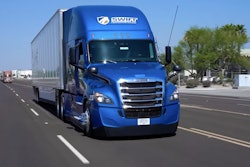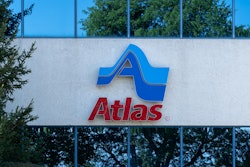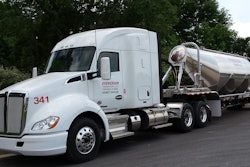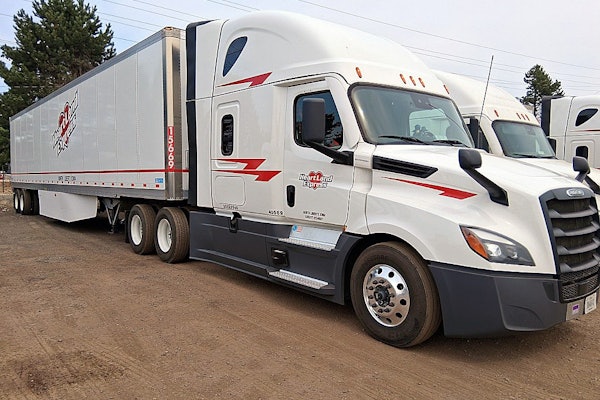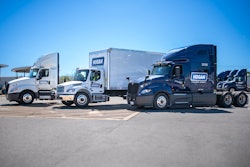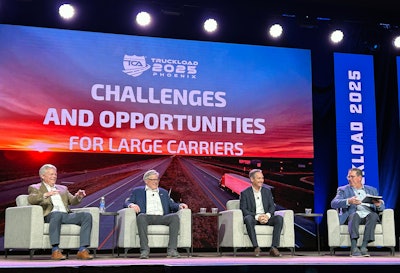
The workforce. The economy. Political upheaval. Regulatory uncertainty. Motor carriers of all size face no shortage of challenges and problems, including some of the country's largest carriers.
A panel at the Truckload Carriers Association annual meeting in Phoenix Tuesday looked at how four CCJ Top 250 carriers – three of them Top 10 – have addressed a difficult two-plus years.
Motor carriers' costs have been under heavy analysis since the market downtown more than two years ago and those budget decisions were made in lean times under the assumption that the current reality would be far more robust than it actually is.
"Today, the issue is to understand what some of the new issues that are coming toward us are going to do to our business," said Knight-Swift Transportation (No. 4) vice president of equipment and government relations Dave Williams. "We expected things to turn by now, but we're still watching the numbers and waiting for recovery. We're all a little bit flabbergasted how long this has lasted."
Change in the White House hasn't had the kind of quick and positive impact many might have expected. While Williams noted President Donald Trump's second administration does have some business-friendly policies, "we've had some new things introduced that I don't think we were prepared for," including a potential economic recession, he added.
"From a trucking standpoint, I think we just need to be prepared for a potential recovery, but also some prolonged pain," Williams said. "It's a little chaotic right now. I think we expected a little more order."
Underlying all the chaos, "we probably avoided some environmental rules that would have been really detrimental to our industry," Williams said, adding a full conversion to battery electric would have cost Knight-Swift approximately $21 billion – almost three times what his publicly traded company is worth.
To maximize its revenue, Landstar (No. 10) President Joe Beacom said his company focused on the health of its owner-operator network. The company has seen a loss of operators due to elevated operating costs. Beacom called most of Landstar's owner operators "very good business owners," noting Landstar's average operator is 51 years old and running used equipment. "The ones that have done well have learned to lower cost of operation," he added.
Landstar, Beacom said, is focusing on growth in specialized areas like over-dimensional loads, where the barrier to entry is a little higher, keeping competition low. That's a strategy Beacom said would serve all motor carriers in difficult times.
"Find the things that you do particularly well... things that are a little bit more difficult. Look at the things not everybody else can do or wants to do... or has the cash flow to get into," he said.
"The important thing is to find ways to create value," Williams added. "Finding things that are the hardest things to do because you don't have a lot of competition, because that's where you're going to get rewarded."
Steve Brookshaw, TFI International (No. 5) senior executive vice president, said his company has put a greater emphasis on an area that it historically has lacked focus: sales.
"We're really looking on our revenue side," he said. "How do we improve the velocity of our trucks? What can we do to make it better for us? We need to drive that improvement ourselves."
A lot of TFI's growth through the years has been driven by acquisition, and Brookshaw noted work has been ongoing to maximize integration and "tear down the walls... between all these businesses."
The panel pushed back on the idea that larger carriers have fewer problems than their smaller counterparts simply because they have more trucks and larger budgets.
"If you can't make money with one truck, you can't make money with 20,000 trucks," Williams said, adding economies of scale don't always favor large carriers in cases of driver turnover and working with smaller customers that tend to be easier to manage.
"The big customer drives your business, but it's also the big customer that drives you nuts," said Mark Seymour, CEO of Kriska Transportation Group (No. 238).
"There's a lot of things a smaller carrier can do to compete with a larger carrier," Williams said. "It's a matter of going back to that single truck and asking 'What are we doing with each truck in order to stay profitable?"
Finding profits have proven difficult as neither the contract nor spot market has been a haven for consistently healthy rates.
More than 90% of Landstar's business comes from the spot market and Beacom said the carrier has struggled to get a larger share of contract due mostly to its owner operator business model. "[The spot market] is great place to be," he said, "but the last 27 months have been not that rewarding."
Williams said shuffling business between contract and spot market is a healthy practice, "but the timing of that is important," as most carriers want more contract business in a bad market and shift to more spot as the market recovers.
Owner operators are an important part of the business, but regulations passed under Joe Biden's administration have inserted some obstacles in the carrier-owner operator business relationship.
"We need to do everything we can to support the owner operator part of the market," Williams said, adding Knight-Swift has dwindled its owner operator roll on the backs of more complex contract employee regulations like AB 5.
However, carriers clearly can make those relationships work for both parties as Landstar is 100% owner operator.
"If you create boundaries and everybody knows where the boundaries are, it works great," Beacom said, adding Landstar's average turnover is about 30% with only about 2% turnover attributed to drivers who depart over a problem with the carrier itself.
Driver wages have climbed in recent years as more motor carriers go head-to-head for driver talent. Freight rates haven't kept up with wage growth, but the panelists agree that driver wages are not an area where there are savings to be had.
Williams said there's little incentive to try and reduce driver wages because "we've fought hard to catch up to industries like construction. And we've done that," he said. "We're waiting for rate. Once that starts to improve, we're looking to share some of that with our drivers."
"The very last lever you'd ever want to pull on is to cut pay for people," Seymour added.





